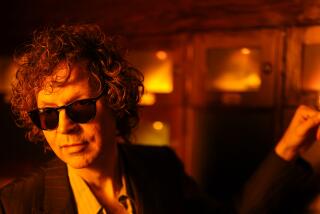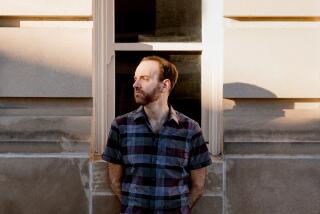A new map to Björk’s music
- Share via
It’s a sad irony: The digitization of music has impoverished the average listening experience. Not only do compressed files sound meager compared to the sonic prowess of good old vinyl, but buy an album on iTunes and you also don’t even get production credits, let alone booklets full of strange photos and imponderable lyrics.
And then comes “Biophilia.”
Björk’s seventh album hits stores Tuesday as not just a collection of MP3s or a compact disc. The best way to experience “Biophilia” is to download it as a free iPad, iTouch or iPhone app, then purchase apps for the individual tunes. In this way, you not only get an animated version of evanescent songs with nature-oriented names such as “Solstice” and “Virus” but you also get a game that allows players to manipulate musical elements, a vocal-less score for esoteric karaoke nights, an essay explaining the history and meaning of each tune and, yes, lyrics. These are liner notes to the nth degree.
Leave it to Björk Gudmundsdóttir — punk-rock wild child, early-bird adapter, Icelandic imagineer — to mine the multitudinous possibilities of information-rich gadgetry and reinvent the album as a transformative transmedia experience.
“This project started on touch screen and ended on touch screen,” Björk said by phone from Reykjavik. “I started out thinking that I wanted to map out how I see songs, like how I write with touch screen, and I wanted to base it on my experience of musical structures.... The fact that I had touch screens, I could map out for the first time the structures associated with my melodies. For me, I guess maybe it is a little idiosyncratic, but I felt it was nature for me.”
Idiosyncratic is probably an understatement when describing the artist who unfortunately may be best known to the masses as the woman in the swan dress (her, er, idiosyncratic choice of an outfit when she performed at the 2001 Academy Awards). Lots of people think Björk is a nut case, an impression not lessened by the berserk-Bozo wig she wears on the cover of “Biophilia” and in the video for “Moon,” in which her elfin lips curve maniacally upward over and over as she strums a harp implanted across her midsection.
But in conversation and in song, Björk inevitably reveals herself as a deep-thinking, hard-working original who’s always looking for the next challenge — an emotion-driven polymath constantly seeking new tools and outlets for creative expression. The woman’s a Björkaholic.
“Funnily enough, my intention in the beginning was to simplify stuff,” she says of the sprawling project dubbed “Biophilia.” “It’s sort of like a weird spring cleaning. You go in the attic and tidy up the attic, and before you know it you paint the house and have done all the rooms.”
To call “Biophilia” an album is really a misnomer: It’s a quintessential example of a work of transmedia, an academic and industry buzz word for creations that tell their stories across multiple platforms. There’s the audio version of “Biophilia” and the multimedia app. It is also an educational workshop, museum installation and performance series.
“Biophilia” began as a science film with Björk’s longtime video maker, Michel Gondry (“Eternal Sunshine of the Spotless Mind”). When that iteration ran into roadblocks, Björk started developing the songs as not just sonic recordings but also as visualized compositions. The touch-screen instrument she had been using in concerts enabled her to completely change her songwriting process.
“I probably write most of my melodies walking outside. I’ve been doing that since I was a child,” says the former singer for the Icelandic new wave group the Sugarcubes, who recorded her first album at age 11. “My accompaniment has always been nature in a funny way.... So this is the first time I have really written like this, and for me it was exciting, and it helped me get out of stagnated methods.”
The globe-trotting explorer whose previous recordings had been inspired by Spanish beaches, New York bridges and of course Iceland’s landscape of ice and volcanoes now had a virtual world at her fingertips.
“With a touch screen, you’re more self-sufficient. You have a library of landscapes, locations.”
Björk used cyberspace to explore inner and outer space. Each song on “Biophilia” tackles a different scientific subject. The music is appropriately experimental and atmospheric. “Crystalline” cracks to life with drum and bass break beats; “Cosmogony” rolls psychedelically. On some songs, Björk used an algorithm to create the bass line. The singer has been seriously geeking out.
But she counters the technophilia by using unprocessed vocals and acoustic instruments, albeit wired for digital sound. Because Björk conceived “Biophilia” as an educational tool for kids, she wanted it to be grounded in physical objects — not just touch screens but also human touch. Along with traditional sound tools such as pipe organs, she and her collaborators created special instruments, such as a gameleste — a mash-up of a gamelan and a celeste — and pendulum percussion instruments.
“I didn’t want them to get stuck inside that virtual reality,” she said. “I want them to have some sort of exit route into the real world of oxygen and hair and wood.”
As always, Björk — who in 2010 won the Polar Music Prize from the Swedish Academy of Music — has surrounded herself with other imaginative free spirits. Avant-garde harpist Zeena Parkins is back, as is beats master Matthew Herbert and writer Sjón Sigurdsson. There are app programmers and scientists. Even Mr. BBC nature-doc narrator David Attenborough chips in with his world-wise observations.
Björk premiered “Biophilia” at the Manchester International Festival in England in June. She conducted workshops for students that mixed scientific explorations with musicology. Then she performed the tracks live, supported by her pendulums and a women’s choir.
“I’ve always been attracted to new formats, because the iron is still hot and you can mold it,” Björk says. “It’s an opportunity to go by impulse or intuition or poetic license.”
More to Read
The biggest entertainment stories
Get our big stories about Hollywood, film, television, music, arts, culture and more right in your inbox as soon as they publish.
You may occasionally receive promotional content from the Los Angeles Times.










